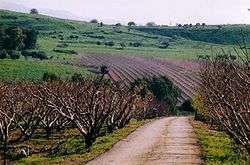Yuval
| Yuval יוּבַל | |
|---|---|
| Hebrew transcription(s) | |
| • official | Kfar Yuval |
 | |
 Yuval | |
| Coordinates: 33°14′48.11″N 35°35′53.51″E / 33.2466972°N 35.5981972°ECoordinates: 33°14′48.11″N 35°35′53.51″E / 33.2466972°N 35.5981972°E | |
| District | Northern |
| Council | Mevo'ot HaHermon |
| Affiliation | Moshavim Movement |
| Founded | 1953 |
| Founded by | Jerusalemite refugees |
| Population (2015)[1] | 634 |
| Name meaning | Creek |

Yuval (Hebrew: יוּבַל), also known as Kfar Yuval (Hebrew: כְּפַר יוּבַל), is a moshav in northern Israel. Located in the Galilee Panhandle between Metula and Kiryat Shmona, it falls under the jurisdiction of Mevo'ot HaHermon Regional Council. In 2015 it had a population of 634.
History
The moshav was founded in 1953 by evacuees from the Old City of Jerusalem who originally arrived from Kurdistan on land that had belonged to the depopulated Arab village of Abil al-Qamh.[2] It was named "Yuval" (creek) after the Jordan river's tributaries in the area and also referring to Jeremiah 17:8[3] ("sends out its roots by the creek"). In the early 1960s most of the founders abandoned the moshav, and it was repopulated by Indian Jewish immigrants from Kochi.[4]
The proximity of the moshav to the border of Israel with Lebanon has made it a target for terrorist attacks. In 1975 a group of terrorists infiltrated the moshav, took control of a residence, and killed three members of one family. [5][6]
The main economic branches of the moshav, as of June 2004, are a chicken coop and plantings of avocado, apples, and plums. In recent years the moshav has relied on tourism from Israelis, and it is one of the leading places for village-style hospitality in northern Israel.
References
| Wikimedia Commons has media related to Yuval. |
- ↑ "List of localities, in Alphabetical order" (PDF). Israel Central Bureau of Statistics. Retrieved 16 October 2016.
- ↑ Khalidi, Walid (1992). All That Remains: The Palestinian Villages Occupied and Depopulated by Israel in 1948. Washington D.C.: Institute for Palestine Studies. p. 429. ISBN 0-88728-224-5.
- ↑ Bitan,H. (1999). 1948-1998: Fifty Years of 'Hityashvut': Atlas of Names of Settlements in Israel. Jeruusalem: Carta, p.27
- ↑ Reliving Cochin memories The Hindu, 14 October 2010
- ↑ Palestinian Raiders Hold Israel Family But Then Are Slain New York Times, 15 June 1975
- ↑ Terrorists Attack Israeli Villagers Herald-Journal, 16 June 1975